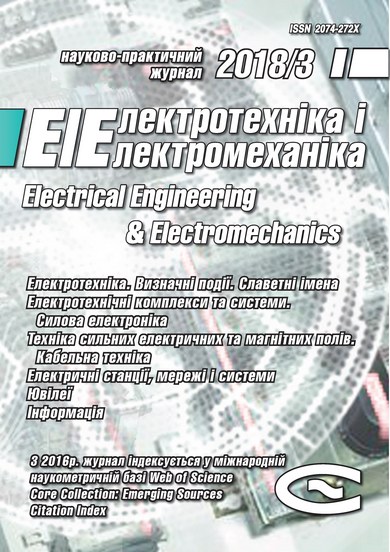REGULARITIES OF ELECTROMAGNETIC PROCESSES OF A CONTACTLESS EXCITATION SYSTEM OF AN ASYNCHRONIZED GENERATOR BASED ON A CASCADE THREE-PHASE-THREE-PHASE VOLTAGE MODULATOR IN A SINGLE-STAR CIRCUIT
DOI:
https://doi.org/10.20998/2074-272X.2018.3.02Keywords:
asynchronized generator, voltage modulator, switch, contactless excitation system, slipAbstract
The regularities of electromagnetic processes occurring in a noncontact excitation system of an asynchronized generator based on a cascade three-phase – three-phase voltage modulator in a single-star circuit for the possibility of expanding the range of a two-zone slip of a generator are established. A method for correcting the parameters of the machines’ rotors of modulator and generator is proposed which makes it possible to stabilize the operation of the switch for the slip range from minus one to plus five tenths with maintaining the performance of the asynchronized generator.References
1. Vasyliv K.M. Mathematical model of dynamic processes of an autonomous electric power system on the basis of contactless asynchronized generator with a three-phase-three-phase cascade modulated exciter. Technical electrodynamics, 2004, no.5, pp. 50-55. (Ukr).
2. Vasyliv K.M. Regularities of electromagnetic processes in the contactless excitation system of an asynchronous generator following a two-star scheme based on a threephase-threephase voltage modulator. Bulletin of NTU «KhPI», 2016, no.32(1204), pp. 48-52. (Ukr).
3. Galinovskiy A.M. Non-contact asynchronized generator with a modulated frequency converter. Trudy І Mezhdunarodnoi (ІІІ Vserossiiskoi) konferentsii po Elektromekhanotronike [Proceedings of the 1st International (III All-Russian) Conference on Electromechanotronics]. St. Petersburg, 1997, pp. 182-192. (Rus).
Downloads
Published
How to Cite
Issue
Section
License
Copyright (c) 2018 K. M. Vasyliv

This work is licensed under a Creative Commons Attribution-NonCommercial 4.0 International License.
Authors who publish with this journal agree to the following terms:
1. Authors retain copyright and grant the journal right of first publication with the work simultaneously licensed under a Creative Commons Attribution License that allows others to share the work with an acknowledgement of the work's authorship and initial publication in this journal.
2. Authors are able to enter into separate, additional contractual arrangements for the non-exclusive distribution of the journal's published version of the work (e.g., post it to an institutional repository or publish it in a book), with an acknowledgement of its initial publication in this journal.
3. Authors are permitted and encouraged to post their work online (e.g., in institutional repositories or on their website) prior to and during the submission process, as it can lead to productive exchanges, as well as earlier and greater citation of published work.





